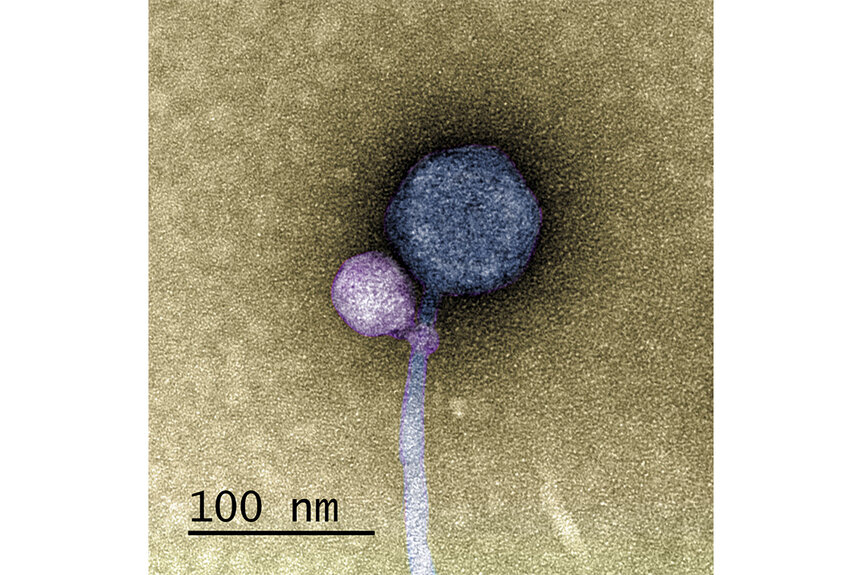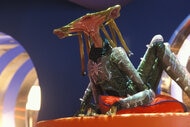Create a free profile to get unlimited access to exclusive videos, sweepstakes, and more!
First Known "Vampire" Virus Latches onto the "Necks" of Other Viruses to Survive
There are some experiences worse than death, Renfield.
Dracula (Nicolas Cage) might be a fearsome undead creature – the prince of darkness and king of vampires – but he is wholly dependent on his semi-human familiar, Renfield (Nicholas Hoult), to operate among the living. To see Renfield’s story (available from Universal Pictures) play out on screen might suggest that he’s the victim, but Renfield is the only one capable of living a full life on his own. Without him, Dracula is nothing.
Of course, Dracula and Renfield are fictional characters, but their relationship dynamic plays out on a trillion microscopic stages all over our planet. Recently, researchers identified a new viral duo in soil samples which includes an ordinary bacteriophage (a virus which infects bacteria) which serves as the “helper” and a smaller “vampire” virus which attaches itself to the helper in order to survive. The discovery was published in the International Society of Microbial Ecology (ISME) Journal.
Meet the MiniFlayer Vampire Virus, the First Known of its Kind
All viruses rely on the biological help of organisms to replicate their genetic materials. Most adapt themselves to one or a few organisms, mostly other microbes, and some have adapted to attack particular systems in plant or animal bodies, including our own. Success for a virus means getting inside of a cell and hijacking its machinery to pump out viral copies. In order to survive, a virus needs to have a complete tool kit to get inside and take over a cell. But some viruses don’t have a complete tool kit and need the help of another virus to replicate. These relationships are known as satellite-helper systems and are relatively common in the microbial world.
RELATED: Will We Get a Renfield 2? Director Chris McKay Says Nic Cage’s Dracula Is Not Completely Dead
In most cases, a satellite virus is capable of getting into a cell and incorporating itself, but not capable of replicating. So, they hunker down inside a cell and wait for their helper to show up and replicate their genetic material for them. The vampire virus can get inside of a cell, but is the first known case of a satellite which lacks the genes for integration. That means it can’t wait for its helper to show up, they both have to get inside the cell at the same time. And the vampire virus, dubbed the MiniFlayer, ensures it gets in at the same time by latching onto the “neck” of its helper and riding along.
“What this satellite does which is fairly unusual, this guy has a capsid and a tail stump which it uses to attach to the neck of the helper phage,” Ivan Erill professor of biological science at UMBC and one of the study’s authors, told SYFY WIRE.
Both viruses hang out in the soil and tag team a species of Streptomyces. The larger helper virus – the Renfield of this scenario – was discovered by undergraduate students as part of the SEA-PHAGES (Science Education Alliance-Phage Hunters Advancing Genomics and Evolutionary Science) program, a two-semester program in which students gather samples in the field, and discover, identify, and characterize new phages. The samples were taken back to the lab where the students named it the MindFlayer, after the popular Stranger Things villain, and sent it off for genetic analysis over the winter break.
“The SEA-PHAGES program has a webpage where you can see all the phages that have been isolated and you can list them by year. Looking at the names you can sort of track popular culture because the students tend to make references to whatever is happening,” Erill said.
RELATED: Scientists Pulled a New Type of Virus from the Deepest Spot in the Ocean
When everyone came back, they found that the sample had contamination. The lab said they’d detected a second genetic sequence in the sample, so the team broke out the transmission electron microscope (TEM) to take a look for themselves. That’s when they found a second, smaller virus latched onto the MindFlayer. The MiniFlayer moniker arose naturally.
Under the microscope, researchers found that roughly 80% of the MindFlayers had a MiniFlayer attached to their “neck,” just where the tail attaches to the capsid. Moreover, some of the MindFlayer virions had what looked like “bite marks” where they had previously been snatched by a MiniFlayer before escaping.
“What we see is sometimes it [the MiniFlayer] breaks off and the capsid goes away and what remains is the little tail stump attached. We see those tail fibers attached to the neck. When we started seeing these, because we started with the imaging it was so visual that we started calling this thing a vampire,’ Erill said. “So we ended up calling these bite marks. They’re not really bites, but it stuck with us.”
Viruses are already incomplete attempts at life, the undead shadow of biology. Satellite viruses are more broken than most, and the MiniFlayer is the most incomplete we’ve ever seen. It may not be a vampire in the traditional sense, but it fits the bill where it counts. See, the MiniFlayer is the aggressor here. It gets the headlines and the fancy “vampire virus” name, but it is powerless without the helper. It is an admittedly cool scientific discovery, but the MiniFlayer is small and weak, and the MindFlayer doesn’t need it to be happy.
Feeling familiar? Catch Renfield, available from Universal Pictures.



















